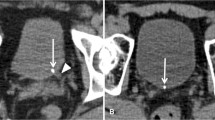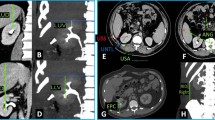Abstract
Background
Computerized tomography (CT) is considered indispensable in percutaneous nephrolithotomy (PCNL) planning. We aimed to define the reliability of pre-PCNL CT for planning renal access by assessing renal positional changes between supine and prone CTs.
Subjects and methods
CT urographies (CTU) of 30 consecutive patients were reviewed for distances upper pole (UP)–diaphragm, UP–diaphragm attachment, renal pelvis (RP)–lateral body wall, RP- posterior body wall, and lower pole (LP)- anterior–superior iliac spine (ASIS). The posterior and lateral renal axes angles were also calculated.
Results
The most consistent overall movement in transition from prone to supine was backward rotation, as demonstrated by a decrease in distance UP–posterior body wall (p = 0.010) and increase in the posterior renal angle (p < 0.0001). This finding correlated with the patient’s body mass index (BMI) (p = 0.029). The left kidney was more mobile than the right one, moving significantly for five of the measured parameters compared to the right kidney which moved significantly for only two parameters. The UP-diaphragm distance of the left kidney correlated with age (p = 0.014), the RP-lateral wall distance correlated with previous abdominal surgery (p = 0.006), and the RP-posterior wall distance with BMI (p = 0.017). On the right, the UP-diaphragm distance correlated with gender (p = 0.002) and the lateral renal rotation was smaller (p = 0.046).
Conclusions
Kidneys present significant mobility between supine and prone positions. CT assessment should be performed in the position expected during surgery and should be interpreted with caution, while a real-time imaging modality should be used in the operating room.






Similar content being viewed by others
References
Assimos D, Krambeck A, Miller NT et al (2016) Surgical management of stones: American Urological Association/Endourological Society Guideline, part I. J Urol 196:1153–1160
Turk C, Skolarikos A, Neisius A et al (2020) EAU guidelines on urolithiasis. In: EAoUG Office EAU guidelines. Edn published as the 35th EAU Annual Meeting, Amsterdam. European Association of Urology Guidelines Office, Arnhem, The Netherlands
Dauw CA, Wolf SW (2021) Percutaneous renal access and drainage. In: Fundamentals of upper urinary tract drainage, 12 edn. Campbell-Walsh-Wein Urology, 12:160–184
Zhao Z, Fan J, Liu Y, de la Rosette J, Zeng G (2018) Percutaneous nephrolithotomy: position, position, position! Urolithiasis 461:79–86
Mourmouris P, Berdempes M, Markopoulos T, Lazarou L, Tzelves L, Skolarikos A (2018) Patient positioning during percutaneous nephrolithotomy: what is the current best practice? Res Rep Urol 10:189–193
Wollin DA, Preminger GM (2018) Percutaneous nephrolithotomy: complications and how to deal with them. Urolithiasis 46:87–97
Klein I, Gutierrez-Aceves J (2020) Preoperative imaging in staghorn calculi, planning and decision making in management of staghorn calculi. Asian J Urol. 7:87–93
Desoky EAE, Eliwa AM, Fawzi AM, Sakr AM, Maarouf AM, Shahin AS, Abdelwahab KM, Ali MM, Abdelrahman H, Zaiton F (2018) Radiologic relation of the colon to the trajectory of percutaneous nephrolithotomy access in prone versus flank-free modified supine position: a prospective study of intra and interindividual influencing factors. Uology 115:71–75
Rassweiler-Seyfried MC, Rassweiler JJ, Weiss C, Müller M, Meinzer HP, Maier-Hein L, Klein JT (2020) iPad-assisted percutaneous nephrolithotomy (PCNL): a matched pair analysis compared to standard PCNL. World J Urol 38:447–453
Duty B, Waingankar N, Okhunov Z, Ben Levi E, Smith A, Okeke Z (2012) Anatomical variation between the prone, supine, and supine oblique positions on computed tomography: implications for percutaneous nephrolithotomy access. Urology 79:67–71
Sofer M, Giusti G, Proietti S, Mintz I, Kabha M, Matzkin H, Aviram G (2016) Upper calyx approachability through a lower calyx access for prone versus supine percutaneous nephrolithotomy. J Urol 195:377–382
Hulin L, Yuanbo C, Chunxiao L, Bingkun L, Xu K, Susu B (2013) Construction of a three-dimensional model of renal stones: comprehensive planning for percutaneous nephrolithotomy and assistance in surgery. World J Urol 31:1587–1592
Levine J, Neitlich J, Smith RC (1999) The value of prone scanning to distinguish ureterovesical junction stones from ureteral stones that have passed into the bladder: leave no stone unturned. AJR Am J Roentgenol 172:977–981
Tamm EP, Silverman PM, Shuman WP (2003) Evaluation of the patient with flank pain and possible ureteral calculus. Radiology 228:319–329
Kourmpetis V, Dekalo S, Levy N, Nir T, Bar-Yosef Y, Beri A, Yossepowitch O, Sofer M (2018) Toward respiratory-gated retrograde intrarenal surgery: a prospective controlled randomized study. J Endourol 329:812–817
Karaimcheti A, O’Donnell WF (1977) Percutaneous nephrolithotomy: an innovative extraction technique. J Urol 118:671–672
LeRoy AJ, Williams HJ Jr, Bender CE, Segura JW, Patterson DE, Benson RC (1985) Colon perforation following percutaneous nephrostomy and renal calculus removal. Radiology 155:83–85
Vallancien G, Capdeville R, Veillon B, Charton M, Brisset JM (1985) Colonic perforation during percutaneous nephrolithotomy. J Urol 134:1185–1187
Lima E, Rodrigues PL, Mota P, Carvalho N, Dias E, Correia-Pinto J, Autorino R, Vilaça JL (2017) Ureteroscopy-assisted percutaneous kidney access made easy: first clinical experience with a novel navigation system using electromagnetic guidance (IDEAL Stage 1). Eur Urol 72:610–616
Ritter M, Rassweiler MC, Ha¨cker A, Michel MS. (2013) Laser-guided percutaneous kidney access with the Uro Dyna-CT: first experience of three-dimensional puncture planning with an ex vivo model. World J Urol 31:1147–1151
Hamamoto S, Unno R, Taguchi K, Ando R, Hamakawa T, Naiki T, Okada S, Inoue T, Okada A, Kohri K, Yasui T, SMART Study Group (2017) A new navigation system of renal puncture for endoscopic combined intrarenal surgery: real-time virtual sonography-guided renal access. Urology 109:44–50
Author information
Authors and Affiliations
Contributions
IM project initiative, data collection, integration and cooperation between the participating medical centers. ZS data management and analysis. AR radiological design and analysis. KL subanalysis and graphical presentation. HH data collection. RM data collection and analysis. SC radiological interpretation. RM drafting and integrity supervisor. OY overall supervisor. GA study design, technical assistance, radiological interpretation and supervision,manuscript editing. MS study design, protocol development, manuscript writing and editing, overall supervisor.
Corresponding author
Ethics declarations
Conflict of interest
No competing financial interests exist.
Ethical approval
Institutional Review Board (IRB) approval was obtained for this study and patient informed consent was obtained before undergoing the procedures.
Additional information
Publisher's Note
Springer Nature remains neutral with regard to jurisdictional claims in published maps and institutional affiliations.
Supplementary Information
Below is the link to the electronic supplementary material.
Rights and permissions
About this article
Cite this article
Masarwe, I., Savin, Z., Rabinowich, A. et al. Querying the significance of patient position during computerized tomography on the reliability of pre-percutaneous nephrolithotomy planning. World J Urol 40, 1553–1560 (2022). https://doi.org/10.1007/s00345-022-03990-9
Received:
Accepted:
Published:
Issue Date:
DOI: https://doi.org/10.1007/s00345-022-03990-9




